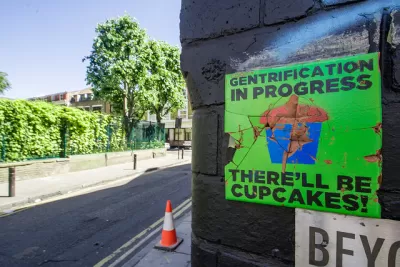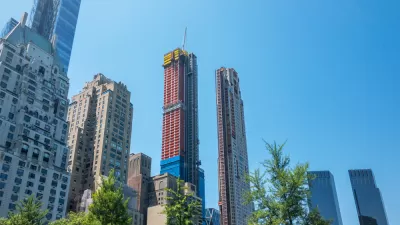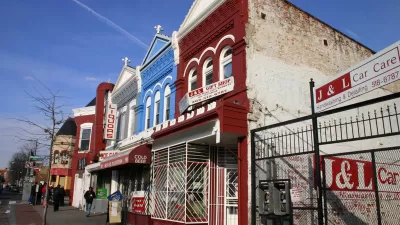The conversation about gentrification continually repackages a set of debunked theories as reality and it obscures a set of real crises that need fixing.

Gentrification has become a functionally useless term.
I don’t know when exactly I reached my breaking point on this issue, though I have been gradually phasing it out over four-plus years of studying neighborhood change. My guess is that it came somewhere between a ridiculous 2019 Jacobin article that claimed that graphic novels “are comic books, but gentrified,” or the turn in this summer’s Black Lives Matter protests when I started watching white people my age parade through Brooklyn screaming “fire, fire, gentrifier.” Whether they arrived here by birth or migration was impossible to tell, but at any rate it would have been impossible for them not to have ridden here on the ongoing “gentrification” wave that originated in the 1980s. If only we millennials had the ability to own our glass houses like so many NIMBY boomers did.
This is all to say that we have a major problem with how we talk about gentrification in this country, a fact true for people all across the political spectrum. First, because the conversation continually repackages a set of debunked theories as reality, and second, because it obscures a set of real crises that need fixing, namely, neighborhood-level inequality, the disappearance of affordable housing, and wages that have lagged behind the rising cost of shelter.
Let’s start by separating gentrification theory from reality. I’ll begin with the common narrative of gentrification, in which wealthy white people and developers move into poor neighborhoods and neighborhoods of color, directly displacing residents with the erection of new, fabulous apartments. This theory was introduced to the U.S. in the 1970s by geographer Neil Smith, but again it was a theory for explaining a new demographic pattern of people moving back to the city from suburbs—a hypothesis unconfirmed, something to be tested. Study after study that has tested it since, the best among them coming from scholars like Lance Freeman and Ingrid Gould Ellen (also, the Federal Reserve) find the theory insufficient.
Beginning with displacement, in a 2005 study covering over 31,000 households from 1980 to 2000, Freeman found that “mobility out of gentrifying neighborhoods is not necessarily dramatically different from mobility out of other neighborhoods.”
A little over a decade later, Ellen also found no significant differences in mobility among low-income residents who lived in gentrifying neighborhoods when tracking over 35,000 New York City children enrolled in Medicaid and who lived in market-rate apartments from 2009 to 2015.
Lastly, Quentin Brummet and Davin Reed, writing in 2019 for the Federal Reserve Bank of Philadelphia, found “moderate,” 4-6 percentage-point increases in mobility rates among less advantaged residents of gentrifying neighborhoods from 2000-2014 (the baseline mobility rate among all renters in the study was 70-80 percent), using a sample population of over 170,000 adults and children and a definition of gentrification based on educational attainment. Rather optimistically, their study also suggested that people who did move from gentrifying neighborhoods seldom ended up in worse-off locations, and that gentrification “creates some important benefits for original resident adults and children and few observable harms.” I’ll offer more on the half-truthfulness of this statement later on.
Next I’ll tackle race, where data along the Black-white fault line of urban segregation runs almost exactly counter to Smith’s theory: It has been the rare exception ...
FULL STORY: “Gentrification” Is Not the Real Problem

Study: Maui’s Plan to Convert Vacation Rentals to Long-Term Housing Could Cause Nearly $1 Billion Economic Loss
The plan would reduce visitor accommodation by 25,% resulting in 1,900 jobs lost.

North Texas Transit Leaders Tout Benefits of TOD for Growing Region
At a summit focused on transit-oriented development, policymakers discussed how North Texas’ expanded light rail system can serve as a tool for economic growth.

Alabama: Trump Terminates Settlements for Black Communities Harmed By Raw Sewage
Trump deemed the landmark civil rights agreement “illegal DEI and environmental justice policy.”

How Community Science Connects People, Parks, and Biodiversity
Community science engages people of all backgrounds in documenting local biodiversity, strengthening connections to nature, and contributing to global efforts like the City Nature Challenge to build a more inclusive and resilient future.

Alabama: Trump Terminates Settlements for Black Communities Harmed By Raw Sewage
Trump deemed the landmark civil rights agreement “illegal DEI and environmental justice policy.”

Dear Tesla Driver: “It’s not You, It’s Him.”
Amidst a booming bumper sticker industry, one writer offers solace to those asking, “Does this car make me look fascist?”
Urban Design for Planners 1: Software Tools
This six-course series explores essential urban design concepts using open source software and equips planners with the tools they need to participate fully in the urban design process.
Planning for Universal Design
Learn the tools for implementing Universal Design in planning regulations.
City of Santa Clarita
Ascent Environmental
Institute for Housing and Urban Development Studies (IHS)
City of Grandview
Harvard GSD Executive Education
Toledo-Lucas County Plan Commissions
Salt Lake City
NYU Wagner Graduate School of Public Service





























